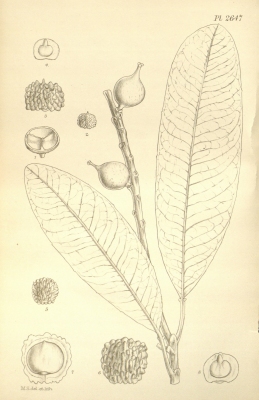Sapium stylare
Müll.Arg.
Euphorbiaceae
Excoecaria stylaris (Müll.Arg.) Müll.Arg.
Sapium cuatrecasasii Croizat
Sapium myrmecophilum Croizat
Sapium putumayense Croizat
Sapium rigidifolium Huft
Sapium solisii Huft
Sapium thomsonii God.-Leb. ex Jum.
Sapium tolimense Jum.
Sapium verum Hemsl.
Common Name:
General Information
Sapium stylare is a tree growing 12 - 18 metres tall.
The tree is harvvested from the wild as a source of latex, which can be used to make rubber. It is possibly also harvested for its wood, which would be traded
Known Hazards
None known
Botanical References
Range
Northern S. America - Ecuador, Colombia, Venezuela, north through Central America to Costa Rica.
Habitat
Primary and secondary forests.
Properties
| Other Uses Rating |      |
| Habit | Tree |
| Height | 15.00 m |
| Cultivation Status | Wild |
Cultivation Details
A plant mainly of elevations above 1,500 metres in the tropics, though it does sometimes descend to almost sea level.
Edible Uses
None known
Medicinal
None known
Other Uses
A latex is obtained from the plant[
46- Title
- Dictionary of Economic Plants.
- Publication
-
- Author
- Uphof. J. C. Th.
- Publisher
- Weinheim
- Year
- 1959
- ISBN
- -
- Description
- An excellent and very comprehensive guide but it only gives very short descriptions of the uses without any details of how to utilize the plants. Not for the casual reader.
]. It can be used to make rubber[
46- Title
- Dictionary of Economic Plants.
- Publication
-
- Author
- Uphof. J. C. Th.
- Publisher
- Weinheim
- Year
- 1959
- ISBN
- -
- Description
- An excellent and very comprehensive guide but it only gives very short descriptions of the uses without any details of how to utilize the plants. Not for the casual reader.
].
We have no more information on the wood for this species, but a general description of the wood from American members of the genus is as follows:-
The heartwood is whitish, yellowish, or light brown; it is not distinct from the cream-coloured sapwood. The texture is medium; the grain straight to slightly interlocked; lustre is low; there is no distinctive odour or taste. The wood has a low resistance to decay and insect attack, including dry-wood termites; lumber is particularly prone to blue stain. The wood is reported to air dry rapidly with only slight warping and checking. It works easily because of its low density; sometimes surfaces are fuzzy but it generally machines smoothly; one report indicates a difficulty in sanding. It is used for purposes such as plywood, fiberboard, particleboard, general carpentry, millwork, utility furniture, boxes and crates[
316- Title
- Tropical Timbers of the World. Ag. Handbook No. 607.
- Publication
-
- Author
- Chudnoff. Martin.
- Publisher
- USDA Forest Service. Wisconsin.
- Year
- 1984
- ISBN
-
- Description
- Terse details on the properties of the wood of almost 400 species of trees from the Tropics.
].
Propagation
Seed -
If you have any useful information about this plant, please leave a comment. Comments have to be approved before they are shown here.


 Useful Tropical Plants Database 2014 by
Ken Fern,
web interface by
Ajna Fern
with help from
Richard Morris.
Useful Tropical Plants Database 2014 by
Ken Fern,
web interface by
Ajna Fern
with help from
Richard Morris.